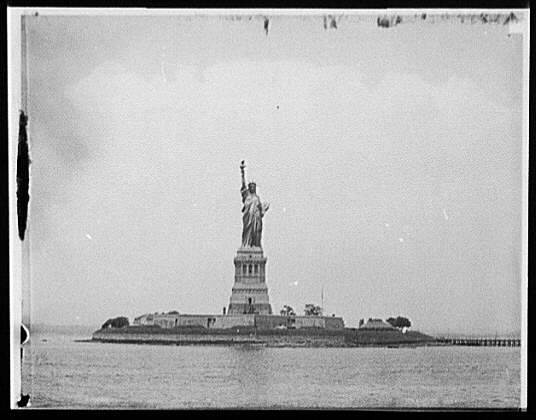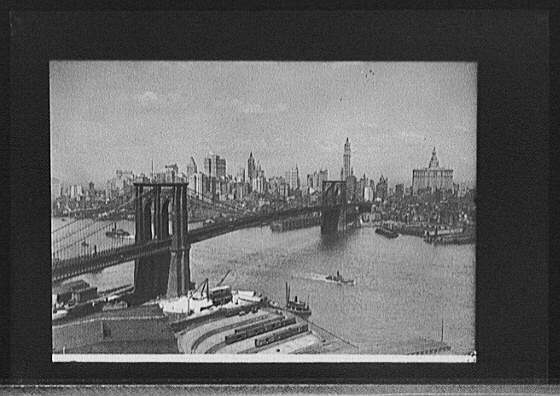There were problems with this from the start. There was no formal placement for these children.
Handbills were handed out in potential farming areas. The children were then taken off the trains and
placed on a platform for prospective 'parents' to examine. Many farmers viewed these children as
a cheap source of labor. Many of the children were abused, though the exact numbers are not known.

The Statue of Liberty
This universal symbol of freedom was a gift from France to express the friendship our two countries had
formed during the American Revolution. It is situated on Liberty Island (once known as Bedloe's Island)
in New York Harbor, where it has been a beacon for millions of immigrants.
The statue was sculpted by Frederic Auguste Bartholdi, while famed engineer Alexandre Gustave Eiffel (who
designed the Eiffel Tower) designed the framework. The intent was to have it finished by 1876, just in time
for the American Centennial. It wouldn't be completed until July 1884. In the meantime, the pedestal was
designed in the US by architect Richard M. Hunt.
The statue was disassembled into 350 pieces and shipped to the US in June 1885 on the French frigate, Isere.
It would take 4 months to completely reassemble the statue and place it upon its pedestal. The statue was officially
accepted and dedicated by President Grover Cleveland on October 28, 1886. It was declared a National Monument on
Monday, October 15, 1924. In 1999, over 5 million people visited Liberty Island.
Facts on the Statue of Liberty
It is 305 feet, 1 inch in height from the ground to the tip of the torch
It is a 22 story climb to the crown
The total weight is 225 tons
Winds in excess of 50 mph cause the statue to sway 3 inches and the torch 5 inches
The tablet reads July 4, 1776 in Roman numerals and is held in the left hand
The proper name of the statue is Liberty Enlightening the World
Symbolism in the Statue of Liberty
The toga symbolizes the Republic of Rome
The torch symbolizes enlightenment
The 25 windows in the crown symbolize gemstones and Heaven's rays shining over the world
The 7 rays of the crown symbolize the both the 7 seas and 7 continents
The chains under her foot symbolize Liberty crushing the chains of slavery
Inscription
The New Colussus
Not like the brazen giant of Greek fame,
with conquering limbs astride from land to land;
Here at our sea-washed, sunset gates shall stand
a mighty woman with a torch
whose flame is imprisoned lightning,
and her name Mother of Exiles.
From her beacon-hand glows
world-wide welcome;
her mild eyes command the air-bridged harbor
that twin cities frame.
"Keep ancient lands your storied pomp!"
cries she with silent lips.
"Give me your tired, your poor,
Your huddled masses yearning to breathe free,
The wretched refuse of your teeming shore.
Send these, the homeless, tempest-tossed to me,
I lift my lamp beside the golden door!"
Emma Lazarus 1849-1887
Bronx
The Bronx is the only mainland borough of New York's five boroughs.
It is 42 square miles in size, comprised of approximately 80 miles of waterfront and is the
center of shipping, warehouses and textiles.
The Keskeskeck Indians sold the area to the Dutch West India Company
in 1639. In 1641, Jonas Bronck purchased 500 acres. The area became
a home for religious dissenters and New England settlers.
The Bronx was acquired from Westchester County in two stages in 1874 and
1895. In 1898, it was incorporated into the City of New York, but remained
part of New York County. In 1912, the Bronx became its own separate county.
The Bronx is home to the Bronx Zoo - one of the world's most notable zoological
gardens - and the World Champion New York Yankees. The 1990 population of the
borough stood at just over 1.2 million people.
The New York Yankees
No baseball team has won more pennants or World Series titles than the Yankees. Many of
baseball's greatest players have worn pinstripes.
The team began as the Baltimore Orioles in 1901 when the American League was first
established. In 1903, they moved to New York City and changed their name to the New
York Highlanders. The year 1920 saw the most controversial trade in baseball history
when Babe Ruth was acquired from the Boston Red Sox for a mere one-hundred-twenty-five
thousand dollars. It was the beginning of not only the Yankees' dominance in baseball, but
also of the Curse of the Babe. In 1923, Yankee Stadium, the House that Ruth built, was
erected.
From 1921-1964, the Yankees won 29 pennants and 20 World Series titles. The 1927 team is
considered to be the greatest team in history. Six members of that storied team have been
inducted into the Baseball Hall of Fame: Babe Ruth, Lou Gehrig, Tony Lazzeri, Earle Combs,
Waite Hoyt and Herb Pennock. Manager Miller Huggins was also inducted.
The Yankees three-peated World Series victories in 1998, 1999 and 2000.
Brooklyn
Brooklyn is the most heavily populated of New York City's five boroughs, with a 2000 population
of just over 2.4 million people. The borough is vital to the United States for its important
industrial setting and it is home to one of the country's leading seaports, due to its extensive
waterfront facilities. Brooklynites have the most recognizable dialect in the United States with
youse guyz, Toid Avenew and the command, Kamere.
Brooklyn was originally inhabited by the Canarsie Indians. They were pushed out when
the Dutch and English settled in the area in 1636-1637. Around the year 1645, Dutch farmers formed
the hamlet of Breuckelen, named after a village in Holland. Breuckelen, Anglicized to
Brooklyn, is near the present-day area of Borough Hall.
In 1664, the six towns of Brooklyn were formed: Brooklyn, Bushwick, Flatbush, Nieuw Amersfoort (aka
Flatlands), Gravesend and New Utrecht. The County of Kings was established in 1683.
Brooklyn was chartered as an independent city in 1834; the village of Brooklyn was incorporated in
1876. In 1898, with a population of 830,000, it became the borough of Brooklyn. Though once home to the
beloved baseball team, the Brooklyn Dodgers, (Da Bums), Brooklyn's most famous landmark is the
beautiful Brooklyn Bridge.
If Brooklyn were an independent city, it would be the 4th largest city in the United States.

Brooklyn Bridge
In 1802, a petition was received by the New York State Legislature to build a bridge over the East
River, connecting Brooklyn with Manhattan. The bill would stagnate for a few decades until being
approved in 1866.
The New York Bridge Company was chartered to build the bridge. Design engineers John Augustus
Roebling and Wilhelm Hildenbrand were signed on. All went well until Roebling died of lockjaw on
July 22, 1869. His son, Civil War hero Washington Roebling, stepped in as chief engineer. That year,
President US Grant signed the bill approving the construction. Work began in 1870.
The Brooklyn Bridge officially opened on May 24, 1883. That first day, 150,300 people crossed on
foot, while 1,800 vehicles made the journey. The initial bridge toll for opening day was one cent,
which was raised to 3 cents the next day. In 1998, 2001 people crossed on foot while 144,000 vehicles
crossed daily.
The Brooklyn Bridge is 3,455 feet 6 inches in length. At the time she was built, it was the first
steel cable suspension bridge - 50% longer than any other bridge at that time. Her construction also
saw the first use of pneumatic caissons. On a humorous note, it is the most purchased bridge in
world history!


